So, you're wondering how to lock up your electric scooter to keep it from getting swiped? The best thing you can do is grab a high-quality D-lock or a heavy-duty chain and fasten your scooter's frame to something solid and immovable. Seriously, this one move is the biggest deterrent there is.
Your Essential E-Scooter Locking Strategy
Leaving an electric scooter unlocked is basically putting a "free scooter" sign on it. As these things have gotten more popular, they've become a hot item for thieves. The stats are pretty grim; across the US, e-scooter and e-bike thefts are on a sharp incline, with some cities reporting thefts have more than doubled in recent years. This drives home a crucial point: a good locking strategy isn't optional, it's essential.
Before we get into the nitty-gritty of how to lock it, we need to talk about what you're locking it with. Picking the right lock is your first and most important line of defense. Knowing the difference between a cheap cable lock and a hardened steel D-lock can be the difference between riding home happy and dealing with the headache of a police report. Of course, knowing how to secure your scooter is just as important as knowing how to ride it safely. You can check out our guide on how to ride electric scooter for tips on that front.
Comparing Your Lock Options
The lock you choose has a huge impact on your scooter's safety. Each type has its own pros and cons, which means some are better for a quick coffee run while others are built for high-risk areas.
Let's break down the most common options to help you decide.
Scooter Lock Security At a Glance
This table gives you a quick rundown of what's out there, what it's good for, and how much of a pain it is to carry around.
| Lock Type | Security Level | Best For | Portability |
|---|---|---|---|
| D-Lock (U-Lock) | High | Securing the frame in high-risk urban areas | Moderate |
| Chain Lock | High | Versatile locking to various objects | Low (Heavy) |
| Cable Lock | Low | Quick, low-risk stops or securing accessories | High |
| Disc Lock with Alarm | Moderate | Secondary deterrent; prevents roll-away theft | Very High |
As you can see, a D-lock or a heavy chain offers the best protection for your scooter's frame, which is exactly what you want for maximum security. Cable locks are convenient, but they're easily snipped—save them for your helmet.
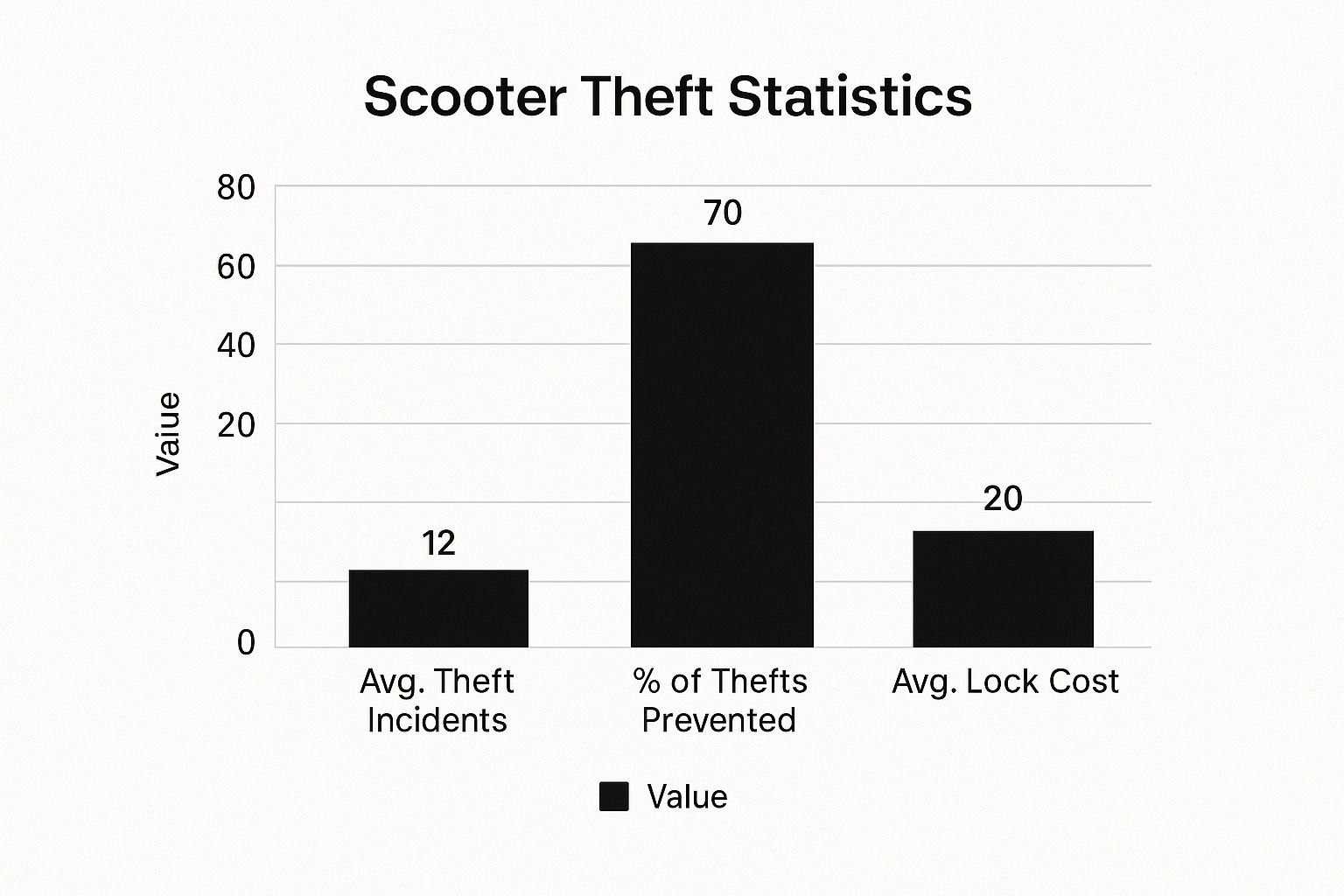
A small investment in a solid lock goes a long way. It dramatically cuts your risk of becoming just another theft statistic.
At the end of the day, your goal is to make your scooter a harder target than the one parked next to it. A beefy, visible lock sends a clear message to thieves: "This isn't worth the trouble. Move along."
Choosing a Lock That Actually Protects Your Scooter
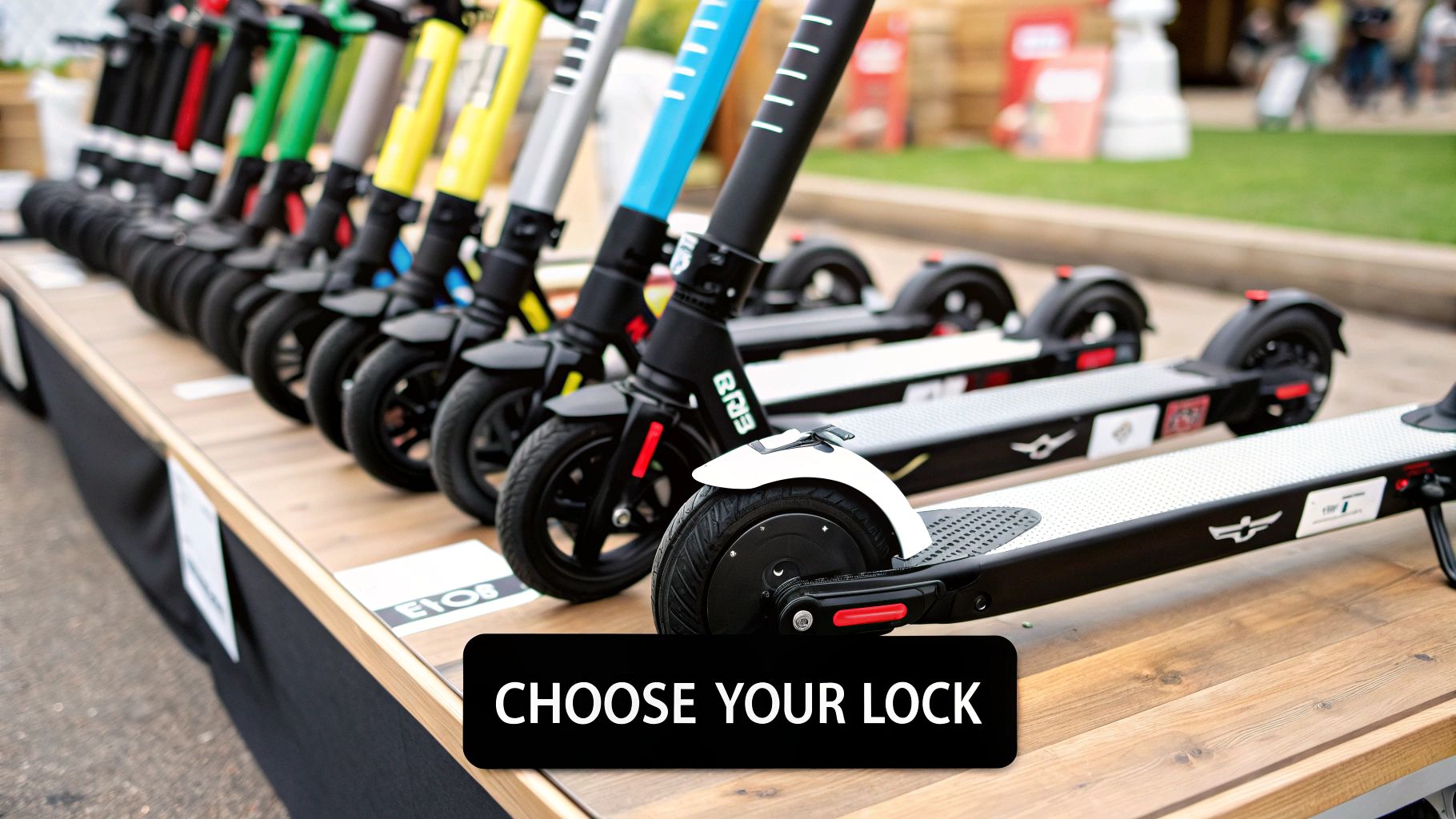
Let’s get straight to the point: the flimsy, coiled cable lock you've been using is practically an invitation for thieves. If you're serious about protecting your scooter, the lock you choose is the single most important decision you'll make. A cheap lock is just a false sense of security, easily snipped in seconds with a pair of bolt cutters.
Your goal is to make stealing your scooter such a loud, time-consuming hassle that thieves just move on to an easier target. That means investing in a lock built with the right materials and, most importantly, one that's been independently tested and rated.
What US and Australian Riders Need to Look For
While Europe has its "Sold Secure" standard, riders in the US and Australia should look for ratings from ART Foundation. This independent Dutch organization is globally recognized for its rigorous testing. Many top-tier lock brands available in North America and Australia submit their products to ART for certification. Their star-based system is a reliable guide to a lock's strength.
- ART 2-Star: Good for short stops in low-risk areas. Think of it as a solid deterrent for a quick trip into a store.
- ART 3-Star or higher: This is the benchmark for securing your scooter in urban environments or for longer periods. These locks are built to withstand more serious attacks from thieves with a range of tools.
Another reliable indicator is a lock manufacturer's own anti-theft protection offer. Companies like Kryptonite offer guarantees where they will pay you a certain amount if your scooter is stolen while secured with their lock. This shows they have serious confidence in their product's ability to resist theft.
A great lock doesn't need to be indestructible. It just needs to be tougher and more frustrating to break than the one on the scooter parked next to yours. It’s all about making your ride the least appealing target on the block.
The Best Locks for the Job
When it comes to high-stakes scooter security, a few types of locks consistently prove their worth. Each has its pros and cons, and honestly, the best defense is often using two different types together.
Hardened Steel D-Locks (U-Locks)
These are the tried-and-true champions of scooter and bike security for a reason. Their rigid shape is tough to pry or jack open. The key is to look for a shackle made from at least 13mm thick hardened steel. Also, make sure it has a double-locking mechanism—this forces a thief to cut through both sides of the shackle, effectively doubling their work and the time they're exposed.
Heavy-Duty Chain Locks
Chains offer something D-locks can't: flexibility. A thick, beefy chain lets you lock your scooter to bigger, more awkward objects like fat lampposts or chunky railings. Look for chains with hexagonal links; their shape makes it incredibly difficult for bolt cutters to get a good grip. Just be sure to pair it with an equally tough padlock, or you've just created a weak link.
Alarmed Disc Locks
Think of this as your scooter's personal alarm system. While you wouldn't use it as your only lock, it's a fantastic secondary layer of defense. It clamps onto your brake disc and lets out an ear-splitting siren—often over 110 decibels—the second it senses movement. It’s enough to make a thief jump out of their skin and draw a ton of unwanted attention before they can even get started on your main lock.
Where to Actually Lock Your Scooter
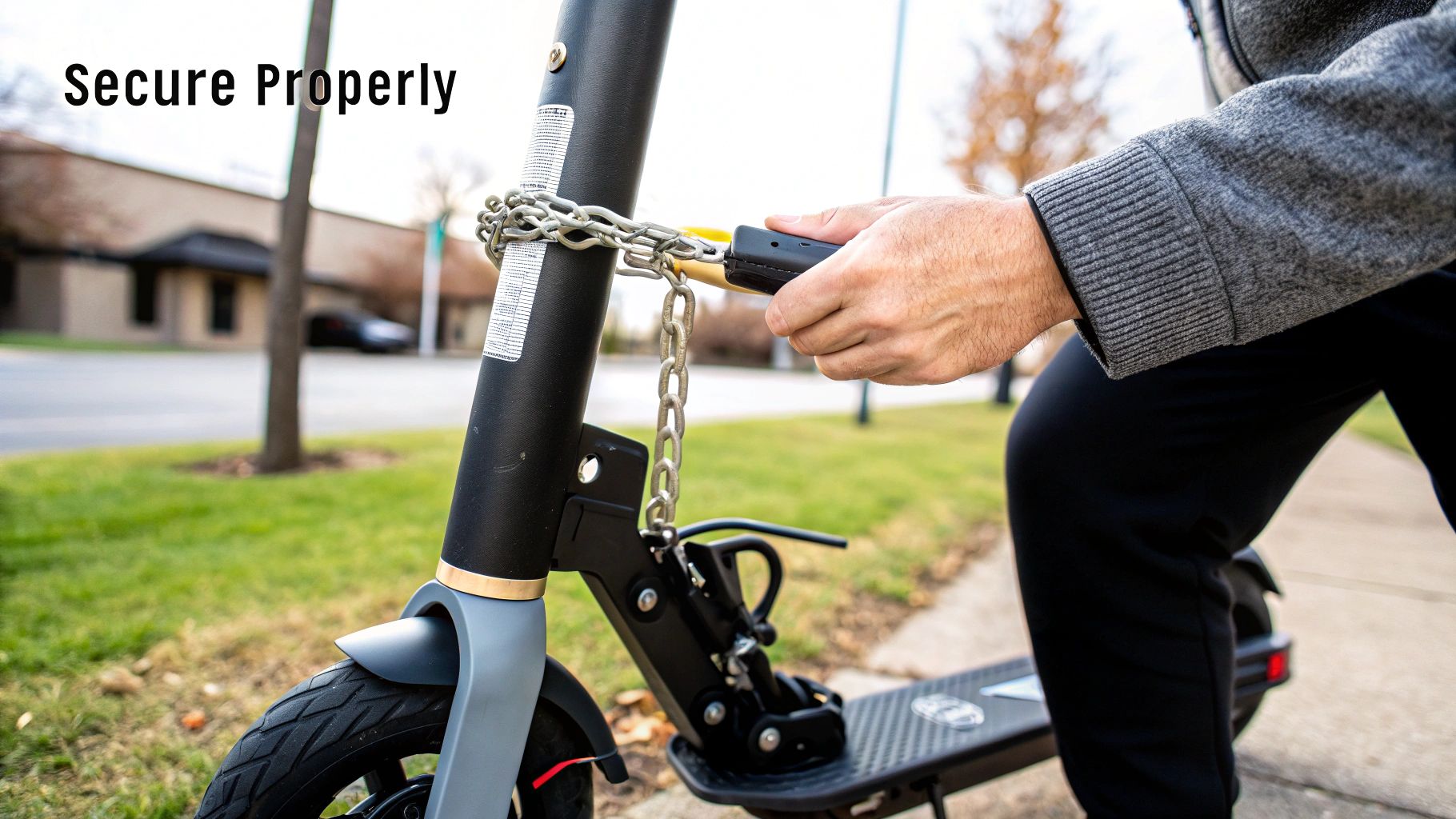
You can drop a hundred bucks on the toughest lock money can buy, but it won't mean a thing if you chain it to something a thief can snap in two seconds. Picking the right spot to lock up is just as crucial as the lock itself. A weak anchor point basically hands your scooter over to the first crook that walks by.
The whole idea is to lock your scooter to something that's way stronger than your lock. You're looking for an object that's literally part of the landscape—cemented into the ground, impossible to lift, and made of solid metal. It's the classic "weakest link" problem; don't let your anchor be that link.
How to Spot a Good Anchor Point
When you're out and about, you need to start seeing the street through a thief's eyes. What looks solid at first glance might be a complete pushover. Training your eye to spot the genuinely secure options is a skill every rider needs.
Here’s what you should be looking for:
- Proper Bike Racks: These are almost always your best bet. I'm talking about the thick, continuous metal loops that are either bolted deep into the pavement or set in concrete. Give it a good shake. If it doesn't budge, you're golden.
- Solid Street Furniture: Think thick metal railings, benches, or bollards that are clearly permanent fixtures. Double-check for any exposed bolts a thief could quickly unscrew.
- Cemented Signposts: A thick, sturdy metal signpost set in a solid block of concrete can be a great alternative. Just be careful it's not a "sucker pole" (more on that below).
And this isn't just a local problem. In the U.S., scooter theft is exploding on university campuses. The University of Pennsylvania police, for example, saw 25 e-scooter and e-bike thefts in just 60 days. They've had to resort to data analysis and even planting bait scooters to catch thieves red-handed. You can read more about how police are responding to rising campus scooter theft.
My golden rule is simple: if you can wiggle it, lift it, or imagine taking it apart with a basic wrench, find somewhere else. Don't even think about it.
Common Anchoring Mistakes (That Thieves Love)
It's easy to make a bad choice when you're in a hurry. So many riders accidentally lock their scooters to things that look secure but are a thief's dream come true, letting them bypass your fancy lock completely.
Steer clear of these classic blunders:
- "Sucker Poles": This is a huge one. These are signposts that aren't actually cemented in. A thief can just unscrew a couple of bolts or even lift the whole pole out of its base, slide your lock and scooter right off the top, and walk away.
- Wooden Fences or Trees: A saw can get through wood quietly and in under a minute. Locking your ride to a flimsy fence post or a skinny tree is just asking for trouble.
- Scaffolding: It might look like a jungle gym of solid metal, but scaffolding is designed to be taken apart quickly with simple tools. It's a definite no-go.
- Chain-link Fences: A pair of bolt cutters will snip through a chain-link fence like it's butter. It offers zero real security.
Locking It Down Right: The Art of Securing Your Scooter
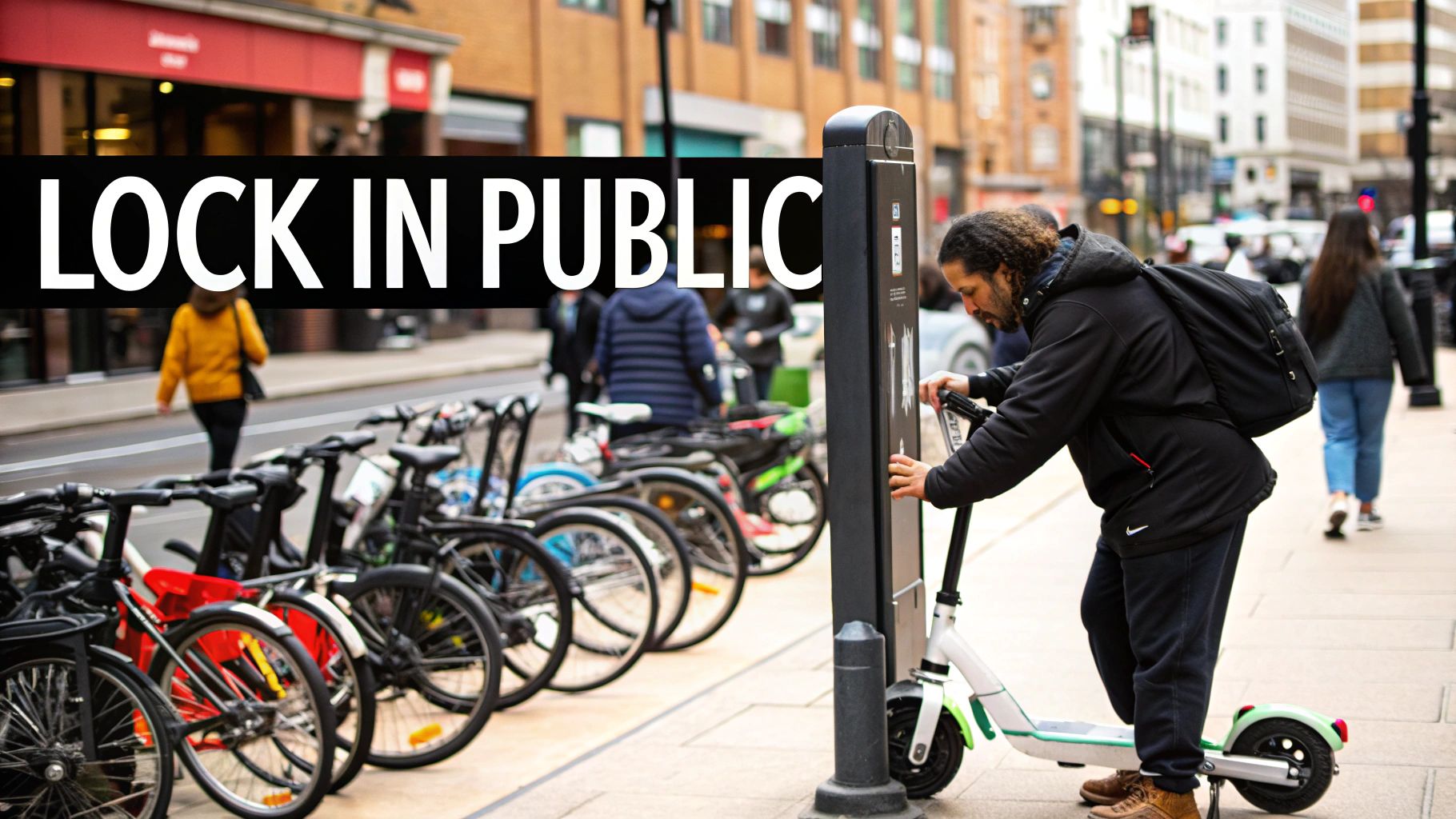
Alright, let's get into the nitty-gritty. You've got a solid lock and you've found a sturdy place to attach it. That's half the battle, but the way you lock up is what really separates a secure scooter from an easy target.
The mission is simple: make your scooter an absolute pain to steal. We want to close off any gaps and kill any wiggle room a thief could use to get leverage with their tools. Trust me, a sloppy lock job can be just as bad as using a cheap, flimsy lock.
The Frame Is Your Anchor
If you take away only one thing from this guide, let it be this: always, always lock the main frame. I can't stress this enough. Never just loop the lock through a wheel. A thief with a basic wrench can have that wheel off in under a minute and walk away with the rest of your ride—the part that actually costs money.
Think of the frame as the scooter's skeleton. Lock that, and you've locked the whole thing. The best spots are usually solid, welded parts of the chassis.
- The base of the stem: This is usually the toughest part of the scooter, right where the steering column joins the deck.
- The folding mechanism: If it's a solid, non-removable part of the frame, it can be a fantastic and secure point.
- A dedicated locking loop: Some manufacturers are smart and include a built-in metal loop just for this. Use it!
The sting of getting your ride stolen is real, and it’s a feeling cyclists know all too well. A recent study found that 44% of bike theft victims get hit more than once. Thieves are creatures of habit. As scooters get more popular and valuable, they're becoming the new favorite target. Your locking technique is your first and best line of defense. If you're curious about the numbers, you can discover more insights about theft trends from Litelok.
Make It Tight, Make It Awkward
Once you've found the sweet spot on your frame, your next job is to get that lock as snug as possible. A tight fit is a thief’s worst nightmare.
A lock with a bunch of empty space inside the shackle is like an open invitation. It gives a thief all the room they need to slide in a crowbar or a car jack and just pop the lock with brute force.
Your goal is to fill that empty space. When you loop your D-lock or chain through the frame and around the anchor point, pull it tight. You want as little daylight showing as possible. This also denies them the space needed to get the teeth of an angle grinder or bolt cutters into a good position.
What About Different Scooter Designs?
Scooters come in all shapes and sizes, and some are definitely easier to lock than others.
- For scooters with open-frame designs: You're in luck. You have plenty of spots to choose from. Just thread the lock through a closed loop in the main structure.
- For scooters with no obvious locking points: This is pretty common with those sleek, minimalist models. Don't panic. You can usually loop the lock around the thickest part of the stem, as close to the deck as you can get it. Just make sure it can't be wiggled up and slipped off over the handlebars.
Here’s a final pro tip: always try to position the lock with the keyhole facing down towards the ground. It’s a simple move, but it makes it much harder for someone to try and pick it or pour nasty stuff like glue or acid inside. The more difficult and frustrating you make it, the more likely they are to just move on.
More Than Just a Lock: How to Really Secure Your Ride
A tough, well-placed lock is your first line of defense, but stopping there is like locking your front door but leaving all the windows wide open. To truly secure your scooter, you need to think in layers. The goal is to make stealing your ride such a hassle that a thief will just move on to an easier target.
Think about it from their perspective. A single lock is one problem to solve. A lock plus a shrieking alarm and a hidden tracker? That's a whole different level of risk and effort. Each layer you add makes your scooter a less appealing prize.
Bring in the Tech
Physical locks are the foundation, but modern tech gives us some incredible backup options. These gadgets can scare a thief off mid-theft or, if the worst happens, help you get your scooter back.
- GPS Trackers: These have gotten so small you can tuck one away deep inside your scooter's frame. If it gets stolen, you can literally track its real-time location on your phone. This turns a hopeless situation into something you and the police can actually act on.
- Motion Alarms: These are my personal favorite deterrent. You can get them built into a disc lock or as a standalone unit. The second someone starts messing with your scooter, it lets out an ear-splitting wail. You'd be surprised how quickly a thief disappears when 120 decibels of alarm are screaming in their ear.
The whole idea behind layered security is to make a thief's job as difficult, loud, and risky as possible. The more roadblocks you throw in their way, the better your odds.
Simple Habits, Big Impact
Not every security measure costs money. Some of the most effective tactics are just smart habits that become second nature over time. Building these into your daily routine can dramatically lower your chances of becoming a victim.
First off, park smart. Always, always lock your scooter in a well-lit area with plenty of foot traffic. Thieves are opportunists who thrive in the shadows. Putting your scooter out in the open, where people are constantly walking by, is a powerful deterrent. Never leave it in a secluded alley, even for "just a minute."
Next, make your scooter uniquely yours and provably so. Take a photo of the serial number right now and email it to yourself so you always have it. Even better, grab a security marking kit. These use things like invisible UV pens or tiny microdots to mark your scooter in a way that’s nearly impossible to remove. This makes it a nightmare for a thief to sell and way easier for the police to return to you if they find it. Mastering these simple things is just as important as learning how to lock an electric scooter in the first place.
Got Questions About E-Scooter Security? We've Got Answers
https://www.youtube.com/embed/0UdC6XtOmfQ
Even with the best locking strategy, a few specific questions always seem to come up. Nailing down the answers to these is the final piece of the puzzle for feeling totally confident when you park your scooter. Let's dig into what riders ask most often.
Can I Leave My Scooter Locked Outside Overnight?
Look, I'm going to be straight with you: this is a huge risk, and I really, really advise against it. Leaving your scooter out all night hands a thief two massive advantages—the cover of darkness and a ton of uninterrupted time to go to work on your locks. Give a pro enough time, and even the toughest lock will eventually give way.
Now, if you're in a real bind and have absolutely no other choice (maybe you're in a tiny apartment with zero storage space), then you have to go all-out on precautions. Find the busiest, most brightly-lit spot you can, ideally right in the view of a security camera. This is a situation where using multiple, high-quality locks isn't just a suggestion; it's essential.
Think of locking your scooter outside overnight as an absolute last resort, not a nightly routine. The longer it's out there, the more the odds stack against you. Get it inside whenever you can.
At the end of the day, it's all about minimizing risk. A scooter safely tucked away indoors has a pretty much zero-percent chance of getting stolen. But one left on a quiet street overnight? It just became a very tempting, easy target for any thief doing their late-night "shopping."
What's the Best Part of the Scooter to Lock?
This is a critical one, but thankfully the answer is simple: always, always lock through a solid, non-removable part of the main frame. Please, whatever you do, don't just lock the wheel. A thief can have a wheel off in less than a minute, leaving your lock dangling while they stroll away with the most valuable part of your scooter.
For most models, your best bet for a secure locking point will be:
- The base of the steering stem, right where it connects to the deck. This is usually the thickest, most reinforced part of the whole scooter.
- A dedicated metal loop that the manufacturer has welded or built directly into the frame. If your scooter has one of these, that's your spot.
- A solid piece of the chassis or folding mechanism, as long as you're certain it can't be quickly unbolted or taken apart.
Steer clear of locking through any flimsy plastic bits, the handlebars, or any component that looks like it could be removed with a simple tool. Your lock is only as strong as the thing it's locked to. Securing the core of the scooter is the only way to make sure the whole thing is still there when you get back.
Are Two Cheap Locks Better Than One Good One?
It's a tempting thought, but unfortunately, it doesn't really pan out. Two cheap locks often have the exact same vulnerabilities. A thief who brought a tool that can snip one cheap cable lock can almost certainly snip the second one just as fast. You’ve only made them work for an extra few seconds—you haven't actually made your scooter much safer.
You are far, far better off investing that money into a single, high-quality, ART-rated lock. One truly great lock will fend off a serious attack much more effectively than a bunch of weak ones.
For ultimate security, especially if you live in a high-risk area like New York or a major Australian city, the best setup is to combine two different types of high-quality locks. For instance, pairing a hardened steel D-lock with a heavy-duty chain lock forces a thief to need two completely different sets of tools and a whole lot more time and effort. That two-pronged approach is a massive deterrent that makes most thieves decide your scooter just isn't worth the hassle.
Ready to ride with total peace of mind? Punk Ride LLC has a hand-picked selection of top-brand electric scooters and all the security gear you need to protect your investment. Find your perfect ride and learn how to keep it safe by checking out our collection at https://www.punkride.com.
Article created using Outrank




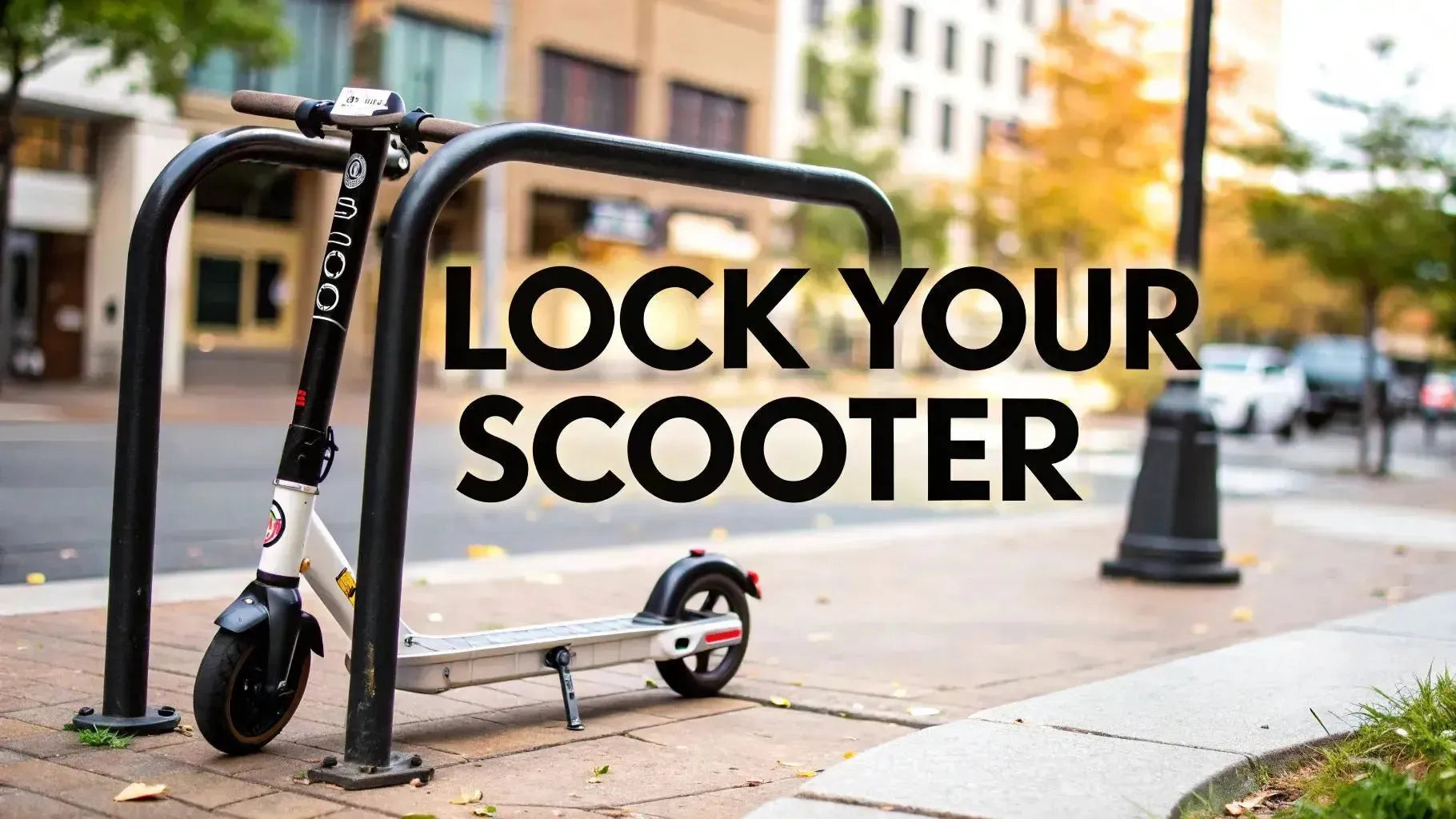
Share:
How to Ride Electric Scooter: A Beginner's Guide
DIY Electric Scooter Tire Replacement Guide